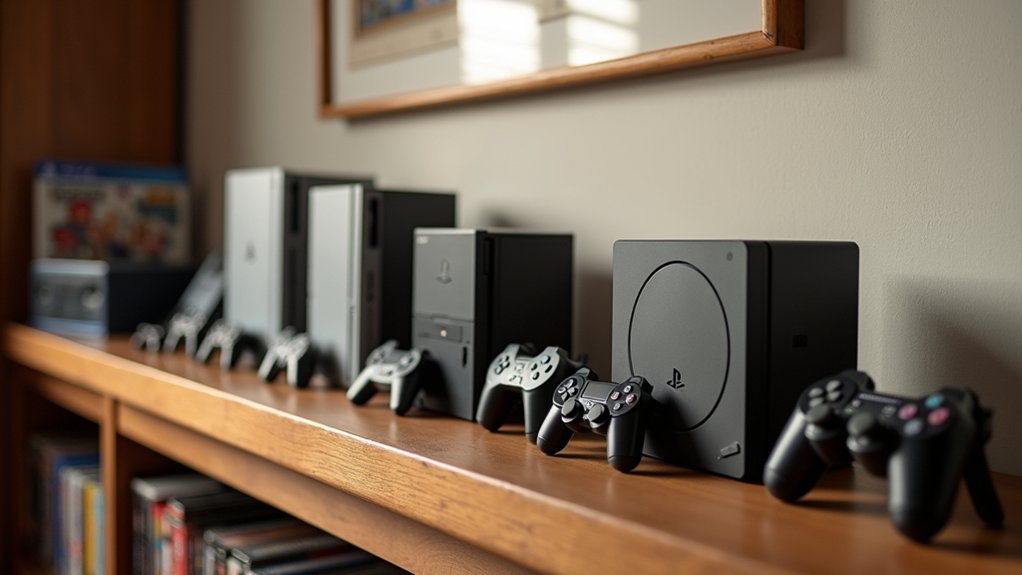
How do I add friends on Nintendo Switch
Need to add friends on Nintendo Switch? Discover simple steps and hidden tips to connect with players worldwide and enhance your gaming experience.


The story of PlayStation isn’t just about consoles—it’s about how gaming itself changed forever. From bold beginnings in the ’90s to shaping the way we play today, PlayStation has left a mark that goes far beyond the living room.

But what moments defined that legacy, and how did it become one of the most powerful names in gaming?
Let’s take a closer look.
The origins of PlayStation began with bold ideas, strategic partnerships, and a vision to change how people play games.
Early collaborations inside Sony led to the formation of Sony Computer Entertainment, a dedicated division created to drive PlayStation innovation and support a fast-growing games market.
This strong foundation helped the PlayStation brand expand rapidly, pushing gaming technology forward and shaping the future of games for players worldwide.
The early concepts and development of PlayStation began with Sony’s attempt to partner with Nintendo on a CD-ROM add-on for the Super Famicom. When the deal fell apart, Ken Kutaragi led a bold, independent push that focused on 3D graphics and CD-ROM technology—key innovations that reshaped console gaming.
This turning point set the stage for PlayStation to become a true gaming powerhouse, influencing how players experienced games, how developers built titles, and how the PlayStation brand evolved across generations.
The formation of Sony Computer Entertainment in November 1993 marked a major turning point for Sony’s role in games.
Moving beyond hardware, Sony created a dedicated division for video game development and publishing, backed by Sony Music and guided by leaders like Shigeo Maruyama and Phil Harrison.
With executive support to push the PlayStation project forward, Sony Computer Entertainment solidified Sony’s long-term commitment to the gaming industry and set the stage for the rise of PlayStation in games.
The PlayStation consoles have changed gaming across five major generations, delivering better graphics, smoother performance, and unforgettable games. The original PlayStation set the stage, bringing 3D gaming to millions.
With the PlayStation 2, Sony expanded its lead thanks to a massive game library and strong developer support. As the PlayStation consoles moved from PS3 to PS5, players saw major upgrades in online features, digital storefronts, and social tools that keep gamers connected.
Today’s PlayStation consoles focus on speed, immersion, and next-gen titles. The PS4 popularized share features and strong exclusives, while the PS5 pushed load times down with ultra-fast SSD storage and introduced advanced visuals with ray tracing.
Across each generation, PlayStation consoles have delivered iconic franchises, thriving communities, and a platform where great games take center stage.
PlayStation (PS1) marked a pivotal moment in gaming history when it launched in Japan on December 3, 1994.
Powered by CD-ROM technology, the PlayStation (PS1) delivered richer 3D graphics, immersive sound, and larger games than its cartridge-based rivals.
Competing with the Sega Saturn and Nintendo 64, it sold over 102 million units worldwide and became a household name thanks to iconic titles like Final Fantasy VII, Metal Gear Solid, and Gran Turismo.
The PlayStation (PS1) redefined console storytelling and gameplay, laying the foundation for the modern gaming era and establishing PlayStation as a dominant force.
The PlayStation 2 (PS2) launched in 2000 and quickly became a landmark in gaming history.
The PlayStation 2 (PS2) delivered enhanced hardware, DVD playback, and seamless backward compatibility, letting fans enjoy both new releases and original PlayStation games.
With an enormous library spanning action, RPGs, sports, and more, the PlayStation 2 (PS2) sold over 155 million units worldwide, becoming the best-selling console ever and shaping gaming culture for decades.
PlayStation 3 (PS3) changed the console scene with high-definition gaming, streaming apps, and a strong focus on online play.
Launched in 2006, the PlayStation 3 (PS3) featured Blu-ray discs for bigger, better-looking games and introduced the motion-sensing Sixaxis controller.
Despite a rocky start for developers, the PlayStation 3 (PS3) built a huge library with standout exclusives like Uncharted and The Last of Us, helping it surpass 80 million units sold by 2013 and cement its legacy in gaming history.
The PlayStation 4 (PS4) stood out among eighth-generation consoles thanks to its streamlined hardware and developer-friendly design, making it easier to create and enjoy great games.
Launched in 2013, the PlayStation 4 (PS4) focused on social features, exclusive titles, and strong third-party support, which helped it build a massive library of must-play games.
With its affordable price, reliable performance, and frequent software updates, the PlayStation 4 (PS4) became a commercial success and a favorite for gamers, reinforcing PlayStation’s dominance throughout its generation.
The PlayStation 5 (PS5) is a powerhouse for modern gaming, delivering fast performance and immersive features that elevate the experience.
Thanks to its custom SSD, the PlayStation 5 (PS5) loads games almost instantly, while its GPU supports ray tracing for realistic lighting and shadows in top titles.
With an 8-core CPU, backward compatibility for most PS4 games, and the DualSense controller’s adaptive triggers and haptic feedback, the console enhances gameplay across genres.
A slim model launched in 2023, keeping the PlayStation 5 (PS5) at the forefront of console gaming and ready for the latest blockbuster releases.
As the gaming landscape evolves, PlayStation consoles continue to push performance and user experience forward.
The PlayStation 5 Pro, reportedly targeting a November 2024 release, is expected to deliver enhanced graphics, faster processing, and smoother frame rates for today’s biggest games.
These PlayStation consoles also prioritize backward compatibility, helping players enjoy existing libraries while benefiting from cutting-edge features like improved ray tracing and upscaling.
With a strong focus on immersive gameplay and a growing ecosystem, PlayStation consoles aim to stay competitive and keep gamers excited for what’s next.
Sony expanded its PlayStation brand into handheld gaming with the PlayStation Portable (PSP) in 2004, a device that blended games with multimedia on the go.
The PSP helped shape the future of portable games by offering console-quality experiences in your hands.
Sony followed up with the PlayStation Vita in 2011, featuring dual analog sticks and advanced touchscreen technology that pushed handheld games forward.
While both devices targeted the growing mobile games market, they achieved different levels of success, but their legacy still influences how we play games today.
The PlayStation Portable (PSP) was Sony’s bold move into handheld gaming, offering a powerful mix of games and multimedia on the go. Launched in 2004, the PSP supported UMD discs and expandable memory, making it a favorite for players who wanted console-quality games in a portable format.
Later models like the PSP-2000 and PSP-3000 refined the design with a slimmer build and a brighter screen, improving the gaming experience. In 2009, the PSP Go embraced digital downloads, removing the UMD drive and focusing on a portable library you could carry anywhere.
Whether you’re into action, RPGs, or racing, the PlayStation Portable (PSP) remains a standout device for classic handheld games, and many fans still revisit the PlayStation Portable (PSP) catalog today.
The PlayStation Vita was a powerful handheld that stood out in a mobile-first era.
The PlayStation Vita launched with a vibrant 5-inch OLED touchscreen, dual analog sticks for precise control, and strong multimedia features that appealed to gamers on the go. Released in 2011, the PlayStation Vita also supported Remote Play with the PS4, giving players console-quality experiences in portable form.
While critics praised its hardware and innovative features, sales slowed over time, and Sony discontinued it in 2019, marking the end of its push in the portable gaming market.
The history of PlayStation is a pioneering journey that reshaped gaming and set new standards for consoles. From its innovative launch in 1994 to the rise of landmark games and powerful hardware, PlayStation has consistently pushed technological boundaries and defined how players experience games. Despite challenges in the portable market, the impact of PlayStation on gaming culture remains profound, inspiring developers, growing esports, and elevating blockbuster games to global fame. As PlayStation continues to evolve with new consoles, services, and exclusive games, its legacy endures—symbolizing innovation, community, and the future of interactive entertainment. This complete look at the history of PlayStation shows how games, technology, and players came together to build a lasting legacy.

Need to add friends on Nintendo Switch? Discover simple steps and hidden tips to connect with players worldwide and enhance your gaming experience.

Properly deleting games on Nintendo Switch frees up space and keeps your system organized; discover the simple steps to manage your library efficiently.

Master the art of charging your Nintendo Switch controller efficiently—discover essential tips and tricks to keep your gameplay uninterrupted and your device ready.

Discover the best methods to safely and efficiently charge your Nintendo Switch—avoid common mistakes that could shorten your battery’s lifespan.

Getting your Nintendo Switch on the big screen is easier than you think, but there’s one crucial step you don’t want to miss.

Unlock the world of Nintendo games by creating your own account—discover the simple steps and essential tips to get started today.